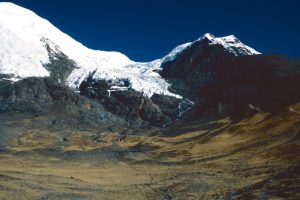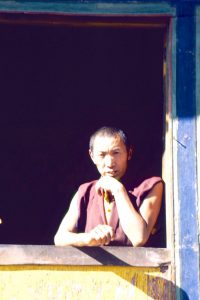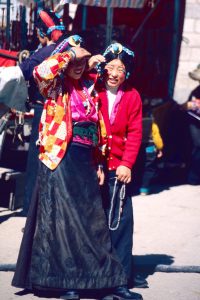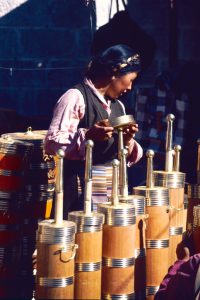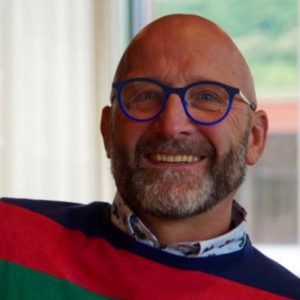During my stay in Tibet I was confronted with reality in a very emotional way. Traveling not only is a matter of having fun, seeing exciting places and meeting interesting people. It’s also an introduction to a wider reality. It makes you more conscious about what’s going on in the world. Not only the good things but also injustice, suppression and violation of human rights. Exactly that is going on in Tibet since 1949 when the Chinese “peacefully liberated” Tibet. This “liberation” lead to the death of 1.2 million Tibetans. This injustice still hasn’t finished yet and that’s the reason why I wave this Tibetan flag on my web site, hoping I will be able to visit this beautiful and once peaceful country again when it’s free!!!
Go and have a look at the following Web site, it contains more information about what’s going on.


Unfortunately the Chinese made it almost impossible to travel individually through Tibet. Therefore I decided to join a tour organized by “Green Hill”, a Nepalese tour operator. I was well aware of the fact that the tour guide would be Chinese so I decided to use the tour as a method of transport only and go my own way as much as possible. This worked out pretty well.
We left Kathmandu early in the morning and headed towards the Himalayas for our 920 kilometer journey to Lhasa. We passed little villages and after a six hour spectacular drive we finally reached the friendship Bridge where we passed the border.
At the border I already noticed for the first time how badly Tibetans were being treated by the Chinese officials. After the checkpoint we had to follow a road which was badly damaged by landslides before we reached Zhangmu where we stayed over for the night.
The next morning we followed the valley of the Bhote Koshi river after which we quickly gained height in order to cross the La Lung-La pass at 5124 meter. The scenery was breathtaking, or was that caused by the fast increase of height. I felt a bit dizzy, a headache was coming up and walking was pretty difficult. However, the scenery was of an almost unearthly beauty.
A stretched desert-like plateau with the Himalayas on the horizon. We visited the Phegyeling monastery with Milerpa’s cave (Milerpa is an important Buddhist lama who lived from 1040 to 1123).
Also it was possible to get a glimpse of the Mt. Everest. Unfortunately I was affected by the altitude and could not enjoy the scenery anymore.
We continued to Tingri where we stayed the night in the Everest View hotel, a nice name for such a shabby place. By the time dinner was served I was really sick and went to bed for a long, cold and restless night.
I did feel a bit better in the morning but could hardly eat from the dry pieces of Tibetan bread and tea which were served for breakfast. I was a bit worried about the upcoming trip as we still had to cross another pass, the Lagpa-La pass at 5220 meters! Luckily things turned out well. On the pass a small pyramid was built and prayer flags were waving in the wind.
We passed some herds of yaks and met people at the most remote places. In the afternoon we arrived in Lhatse. My headache was gone and I felt much better. We were supposed to visit the Sakya monastery but the road was blocked by the Chinese because of riots. Apparently monks refused that pictures of the 14th Dalai Lama were being confiscated causing “irregularities”. Wondering what was going on over there we continued to Shigatse. The road was not very comfortable and the bus shaking all the time while dust was all over making it difficult to breath.
After a good night of well deserved sleep we headed for the Tashilhunpo monastery. Tashilhunpo, like the Drepung and Sera monastery in Lhasa is one of the six big institutions of the Gelugpa order. It was built in 1447 by the 4th Panchen lama.
For my exploration of the monastery I decided to split from the group and enjoy the atmosphere on my own. Behind the philosophy college I saw a giant white wall where the Gheku Thangka is being displayed during special ceremonies. I also noticed the three main buildings of the complex; On the left the Maitreya Chapel with a 26 meter high Buddha statue, in the middle the Kudhung Lhakang with the grave of the 4th Panchen Lama and on the right the Dukhang, which functions as a prayer room.
I wandered through the numerous alleys inhaling the fantastic atmosphere. Everywhere you could sense the smell of incense and butter lights. Inside the monastery it was dark with dark red as the dominating color. I was fascinated by the beautiful architecture and samples of Buddhist art which I saw everywhere. At the back of the monastery I met a monk who led me to a courtyard where more monks were debating. It was an impressive sight.
In the afternoon we visited the Palkor Chode monastery in Gyantse. It’s a unique monastery because it’s the only one in Tibet which is fortificated. I wandered through the assembly hall and enjoyed the many images on the wall in each of the numerous chapels.
It was a beautiful place but I was most impressed by the Kumbum, the most important chorten ever built in Tibet (1440). The Kumbum is eight levels high and like all pilgrims I went up clockwise in a spiral up to the highest level from where I could admire the gold dome and get a good view over Gyantse and it’s dzong.
Time passed by very quickly and unfortunately we we’re late to visit the Gyantze dzong, a fortress which is built on top of a hill. Instead I wandered through Gyantze together with Kevin, my roommate. Gyantze is one of the towns in Tibet which is least influenced by the chinese. Therefor the atmosphere was very special.
The next day we travelled the final stretch to Lhasa. Our tour passed through a gorgeous valley. We still had to cover several passes but they were not as high as those on the first days. The road however was in very poor condition. Because of this the bus ride was extremely uncomfortable.
We had to get out of the bus twice in order to pass some extreme bad spots. Not only the passengers but also the bus suffered a lot and after an inspection in one of the next villages the driver told us it was impossible to carry on because of a broken axe. Although we were only a couple of hours drive from Lhasa it was impossible to arrange another bus. The only solution was to continue our journey in the back of a truck together with some locals and frozen pieces of dead sheep! The trip was even more uncomfortable than the bus ride but it certainly added to the adventurous feeling…
We passed the beautiful Yamdrok-tso lake but unfortunately we could not make a stop because of the delay we already had. After the sun went down it became pretty cold as we had no protection from the wind. Fortunately sleeping bags brought some shelter from the elements. Finally we arrived in Lhasa late at night, tired, dirty but happy to have made it anyway.
There were still two days left to explore
Lhasa and it’s surroundings and of course the first place to visit was
the impressive Pothala, the former winter palace of the Dalai Lama. Next
to the entrance a little market was set-up and pilgrims were rotating
the prayer mills.
Inside the Pothala the
atmosphere was very different. In each room “monks” were posted with
portaphones, camera’s were all over. The chinese did every effort
turning the Pothala into a museum and stating very clearly that this is a
place of the past. I’m afraid I must admit they succeeded pretty well,
it was a creepy atmosphere. I still enjoyed the architecture and the
impressive chapels and rooms within the building but without normal
activity the place seemed to be completely dead. I was followed
everywhere I went which made me feel uncomfortable. I did not stay in
the Pothala longer then 2 hours which is amazing for such an immense
place.
Later that day we grouped
up again at the Barkhor square in order to visit the Jokhang, one of the
most religious buildings in Tibet. At the forecourt of the Jokhang
monks and pilgrims were praying. Thousands of butter lights and candles
decorated the many statues in what seemed to be a festivity of beauty..
Once again I had shivers
all over my body and a couple of tears formed in my eyes. It was so
peaceful and intense. I entered the main assembly hall and instead of
following our guide I continued on my own pace, intensively enjoying the
atmosphere. Behind the main assembly hall are a lot of chapels. Over
here I met a monk and after some general introductions the discussion
became pretty political. I was amazed by his open way of talking and
more and more my antipathy for the chinese grew. Forced abortions and
sterilization’s, murder, torture, humiliation. Why oh why? On a weekly
basis all monks have to sign a list with 6 points like: the recognition
of the “chinese” panchen lama, agreement with the peaceful liberation,
regarding the Dalai Lama as a thread for the country. Of course the
forced signing this list is a complete haux and nothing more then
further attempts of humiliation and indoctrination. Most of the income
of the monasteries flows directly to the chinese so it’s very difficult
to maintain the monasteries. The monk told me all pictures of the 14th
Dalai Lama had been confiscated recently. I carefully asked him if he
was interested in getting some new ones and his eyes started to twinkle
again. I was carrying some pictures with me as I knew beforehand of the
situation. We went into a small chapel where I secretly gave the
pictures to the monk. He was very thankful, kissed the picture and had
tears in his eyes. He wasn’t the only one… We couldn’t talk to long as
spies were all over. Before we said goodbye I was invited for a puja
that evening in the main assembly hall of the Jokhang.
Still impressed by what I
was told I went to the roof from where I had a beautiful view of the
Barkhor square and the rest of Lhasa. The Pothala couldn’t be missed
from this beautiful viewpoint. Besides the ugly chinese “new style”
buildings further up it all seemed so perfect from this point. Once
again my mind was asking why oh why? Back outside I stayed a while on
the Barkhor to look at the countless pilgrims who were gathered here.
They came from all over Tibet which was clearly visible from their
different clothing styles. I decided to join the stream of pilgrims on
the circumambulation route around the Jokhang in a clock-wise direction.
It was a special experience.
In the evening I went back
with Kevin to the Jokhang in order to witness the puja in the main
assembly hall. Monks and pilgrims were saying their prayers and were
singing. Thousands of candles were burning and the smell of yakbutter
and incense was all over. Once again I had shivers all over my body and
tears in my eyes. The monotone sound of singing was very hypnotizing and
I sat down in a corner to undergo the experience. I was totally
fascinated. Once I had short eye contact with the monk who I spoke with
in the afternoon however after exchanging a short sign of recognition
further contact was avoided. I don’t know how long I sat in the main
assembly hall but it must have been longer than two hours. Although
nothing much seemed to happen I knew that these were the two most
intensive hours of my whole trip. Outside I didn’t know whether things I
saw were real or not. I was impressed and confused, it took me a while
to return back and in spite of all the things I heard and saw today I
felt extremely happy, I got a little glimpse of what Tibet was and could
be like…
On the last day of our trip
we visited the Drepung monastery in the morning. It was a beautiful
place. In former days 8000 monks used to live and work over here,
nowadays there are only 500 left… Only two hours were available to
enjoy the beauty of the place. Beautiful colors, a fantastic assembly
hall and countless Buddha statues. In the valley below we could see
Lhasa through the thin clouds of morning fog.
In the afternoon our last
visit brought us to the Sera Monastery. Over here we we’re able to
witness debating sessions. In a small courtyard monks gathered and
debated in a jolly atmosphere. They seemed to be very excited and
enjoying themselves. The debating is an important part of the teachings.
Religious subjects and interpretations are being debated between older,
more knowledgeable monks and their younger colleagues. It was so
different from everything I saw before.
After the debating I still made a short walk through the monastery. For me it was my last goodbye and part of leaving Tibet.
I realized I would never be
the same. Tibet had done something deep inside me in an indescribable
way which had never ever happened during my journeys before… I had
started to love the country and it’s inhabitants. I had also developed
strong feelings of hate and disgust against the chinese system. However,
simultaneously I realized that developing feelings of hate was not the
Tibetan way. It was something I still needed to process in my own mind,
a process which hasn’t stopped until now…
Hopefully my story and my pictures show clearly that the Tibetan heart is still beating. However, time is running out and a solution has to be found soon in order to save Tibet’s unique cultural heritage and Buddhist spirituality.




























































